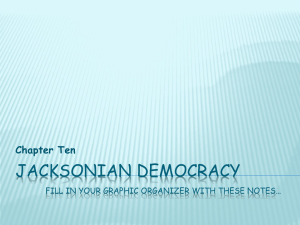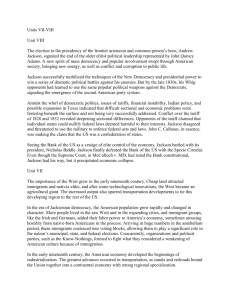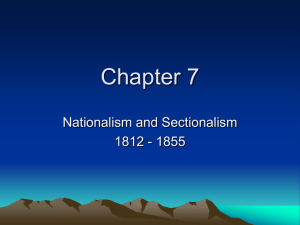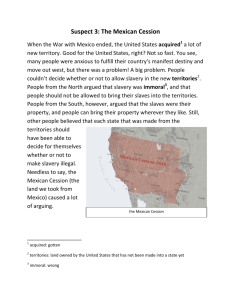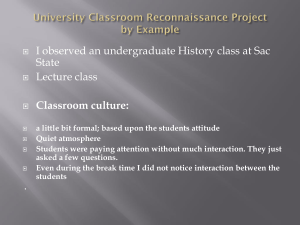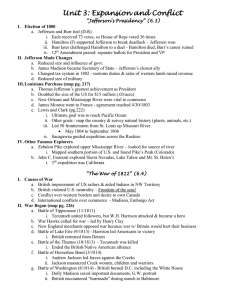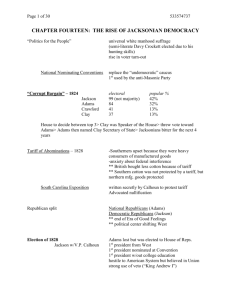UNit 3 Notes AMHISt
advertisement
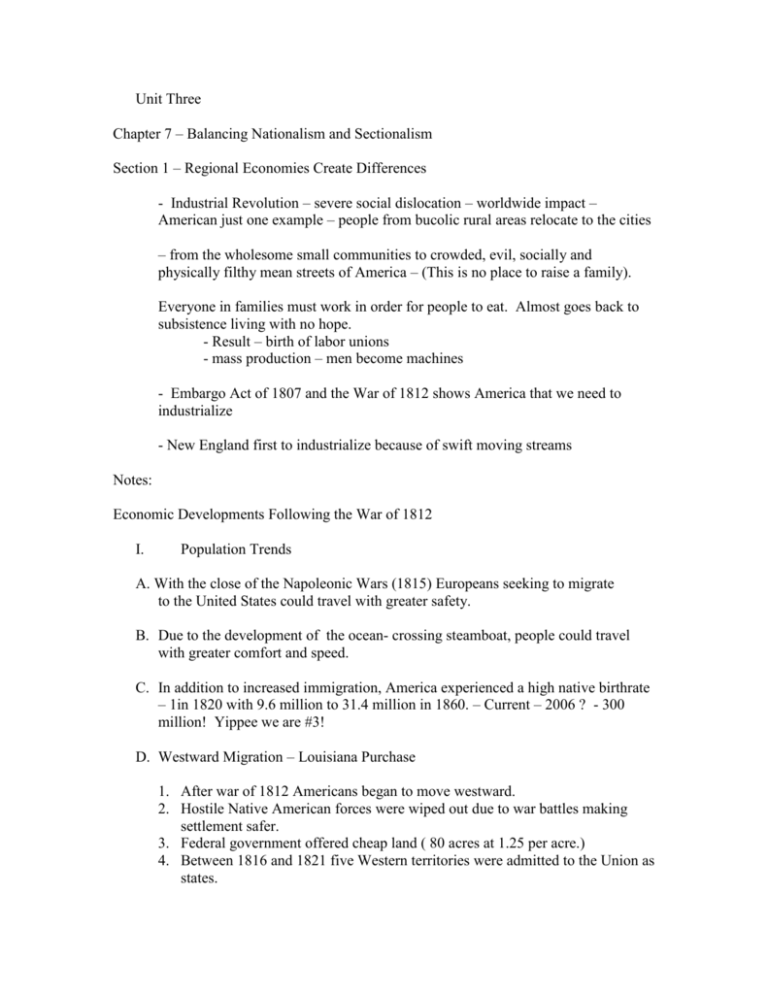
Unit Three Chapter 7 – Balancing Nationalism and Sectionalism Section 1 – Regional Economies Create Differences - Industrial Revolution – severe social dislocation – worldwide impact – American just one example – people from bucolic rural areas relocate to the cities – from the wholesome small communities to crowded, evil, socially and physically filthy mean streets of America – (This is no place to raise a family). Everyone in families must work in order for people to eat. Almost goes back to subsistence living with no hope. - Result – birth of labor unions - mass production – men become machines - Embargo Act of 1807 and the War of 1812 shows America that we need to industrialize - New England first to industrialize because of swift moving streams Notes: Economic Developments Following the War of 1812 I. Population Trends A. With the close of the Napoleonic Wars (1815) Europeans seeking to migrate to the United States could travel with greater safety. B. Due to the development of the ocean- crossing steamboat, people could travel with greater comfort and speed. C. In addition to increased immigration, America experienced a high native birthrate – 1in 1820 with 9.6 million to 31.4 million in 1860. – Current – 2006 ? - 300 million! Yippee we are #3! D. Westward Migration – Louisiana Purchase 1. After war of 1812 Americans began to move westward. 2. Hostile Native American forces were wiped out due to war battles making settlement safer. 3. Federal government offered cheap land ( 80 acres at 1.25 per acre.) 4. Between 1816 and 1821 five Western territories were admitted to the Union as states. E. Impact of Population Trends 1. Need for more farmers. 2. More workers to build transportation facilities and labor in factories. 3. More consumers to purchase food and manufactured goods. 4. More urban dwellers to crowd into old cities and start new ones. Two Economic Systems Develop - Differences in agriculture between North and South - Significant change - cotton gin – SLAVERY becomes entrenched and KING COTTON reinforces THE PLANTATION SOUTH – America is on the road to The Civil War. The American System of Henry Clay – (Role of the West as Compromiser) - developing transportation system and other internal improvements (Interstate highway system) - establishing a protective tariff – ( help Northern industries – make nation more independent) - Tariff of 1816 – beginning of the issue – Era of Good Feelings - resurrecting the national bank Internal Improvements - New York State builds – Erie Canal – NEW YORK CITY becomes the heartthrob of the Universe! - National Road Section 2 – Nationalism at Center Stage - Supreme Court decisions - Fulton and Livingston – Gibbons v Ogden ruling gave the Supreme Court jurisdiction over all interstate matters. - McCulloch v Maryland - - “the power to tax is the power to destroy” – states can not mess with the federal government. - Prevented state interference in business and commerce - Fletcher v Peck - nullified a Georgia state law - Dartmouth College v Woodward – state not go back and undo a contract - Nationalism and Foreign Policy - definition of nationalism - Adams-Onis Treaty 1819 – Home for Disney World – Florida – Map p.221 - Monroe Doctrine – 1823 – President Monroe wanted to keep European powers out of the Western Hemisphere – US could not enforce. - Nationalism Pushes America West – two different “countries” within US + adding new states to the Union will contribute to the tensions that lead to the Civil War. – upset balance in Congress - The Missouri Compromise – know terms of Compromise – “ …, like a firebell in the night” - Map p. 223 – Congress making bad compromises Section 3 - The Age of Jackson – “Old Hickory” - Election of 1824 –- goes to House of Representatives - “ corrupt bargain” Jacksonians leave Republican party- form Democratic- Republican Party white manhood suffrage – free African-Americans and women still out. - Election of 1828 – Jackson has the “common touch” which allows him to take advantage of all the new voters. - Jackson Administration – First Term - spoils system – to the victor goes the spoils. - Indian Removal Act of 1830 - Cherokee Nation lead by Chief John Ross sue - First case Chief Justice Marshall refuses to act - Worcester v Georgia 1832 –decision in favor of Cherokee - however, President Jackson refuses to enforce - Treaty of New Echota – President Van Buren had General Winfield Scott round up Cherokees – conditions and differences Within Cherokee nation on how to proceed. - Trail of Tears – October and November of 1838 – 800 mile trip 25% died on the journey. Section 4 – States’ Rights and the National Bank - Tariff of 1828 – John C. Calhoun, theory of nullification, Tariff of Abominations – Kentucky and Virginia Resolutions - dilemma - John Calhoun – nationalist politician who had to answer the call to represent his state and the South - Hayne and Webster Debates – Senate ( Webster- great oyster eater) – Ye Olde Union Oyster House. – Boston – Oldest restaurant in America. - President Jackson’s position revealed on April 13,1830. Breaks up Calhoun/ Jackson team. Calhoun never a national political figure again. - New Tariff of 1832- South Carolina declares law – “null and void” – Jackson gets Force Bill passed 1833 – ( could have started Civil War) – Clay gets a compromise worked out that will reduce the tariff over a ten year period. - Jackson attacks and defeats the Bank of the United States - Clay and Webster guessed wrong on the issue - pet banks - Biddle miscalculates – Bank eventually dies out. - Martin Van Buren becomes President – 1836 - causes and consequences of the panic of 1837 - Whig candidate William Henry Harrison defeats – Van Buren- John Tyler becomes President one month after the election when Harrison dies. - Chapter Eight - Reforming American Society - Section One – Religion Sparks Reform - Second Great Awakening – “double-edged sword” of religious-based reform – American tradition of superiority - Charles Grandison Finney – “burnt-over district” of Upstate New York - revival – Northern and southern - African-Methodist Church – Richard Allen’s Bethel African Church hypocrisy of reform – still racism*- center of political and social activity The African Methodist Episcopal Church has a unique and glorious history. It was unique in that it is the first major religious denomination in the Western World that had its origin over sociological and theological beliefs and differences. It rejected the negative theological interpretations which rendered persons of African descent second class citizens. Theirs was a theological declaration that God is God all the time and for every body. The church was born in protest against slavery - against dehumanization of African people, brought to the American continent as labor. - Transcendentalism and Reform – Birth of the hippies - Ralph Waldo Emerson - Henry David Thoreau – civil disobedience (Mexican War) – “On Walden Pond” - Unitarianism – “ the perfection of human nature, the elevation of men nobler beings” - utopian communities- Shaker Communities – Carl’s honeymoon! - Prison reform – Mental Health/ Dorethea Dix – Current state - ? - Education reform – Horace Mann – kids in school – “another brick in the wall.” – kids in school not at work - Slavery and Abolition – Section Two - African – American efforts in North (students fill in significance below) - James Forten - David Walker - Frederick Douglass - White abolitionists lead by William Lloyd Garrison - Slavery in the South – (urban and rural) - Nat Turner and other slave revolts – backlash – gag rule. Special NOTE: Horton Hatches the Egg (1940) I meant what I said, and I said what I meant An elephant's faithful, One hundred percent. Section Three - Women and Reform - Cult of domesticity -SNAG - Temperance ,abolition , womens’ education are areas women participate in reform - Southern sisters – The Grimkes - temperance- ATS – 1825 and grows - Education – Grimkes , Willard, Mary Lyon, Prudence Crandall - health concerns for women - Elizabeth Cady Stanton and Lucretia Mott – 1848 organize the Seneca Falls Convention - as a result of abolition convention in London – know quote – p. 257 ERA - Sojourner Truth – abolition and women’s rights advocate Section Four – The Changing Workplace - Textile industry replaces cottage industries ( piecework) – hard work/low pay - Early factories – master, journeyman, & apprentice - rural workers to factory workers – no more “bucolic life” - Lowell system – young rural girls to the work dorm – strikes - Workers seek better conditions while immigration increases – - Irish potato blight in particular - Limited labor successes - National Trades’ Union – 1834- 1837 - Massachusetts case – Commonwealth v Hunt – journeymen bootmakers Chapter Nine – Expanding Markets and Moving West Section One - The Market Revolution – Beginning of Modern America – Consumer culture - Workers need to spend $ on other workers products –let’s go to the market. - capitalism – entrepreneurs – new inventions - Economic Revolution – iPod, iPhone, Nano telegraph, transportation, railroads - Southern Agriculture – Northeast Manufacturing – Midwest Farming Deere, McCormick Section Two - Manifest Destiny – bad for Native Americans - Black Hawk War – Chief and prophet lead revolt that ended unsuccessfully - Treaty of Fort Laramie - Santa Fe Trail – Map page 283 - Oregon Trail – Donner Party – California- 49ers - Mormons – Illinois to Utah – no more polygamy – statehood. - “Fifty-Four Forty or Fight!” - Canada – did not happen Section Three - Expansion in Texas - Mexican Independence opened up opportunities for American expansion - 296 - Why did Mexico invite Americans to settle in Texas? - What role did Stephen Austin play? - Texas Revolution – Remember the Alamo – map p. 291 – San Antonio - Sam Houston – San Jacinto – Lone Star Republic – 1836- 1845 Section Four – The War with Mexico - Texas admittance to the Union + unstable Mexican government + Polk - Why did the Mexican War start? - America acquires California after invasion by Kearney, Fremont, & Sloat - America wins Mexican War ( map p. 296) – - Know conditions of Treaty of Guadalupe Hidalgo - Gadsden Purchase – U of A - California Gold Rush dramatically increases diverse population of California - many fortunes made on people who went to Cali – Levis. DVD- Slavery and the Making of America Harriet Jacobs - owner became “interested” in her at 12 – TJ and Sally Hemmings – What does this tell you about the institution of slavery? - “good looks” a curse - - - he had 12 children with slave women outside of his “regular marriage” What does this tell you about the institution of slavery? Mulatto children sold off No white man felt he was raping a black woman – no such thing What does this tell you about the institution of slavery? Narcum got religion – How did his behavior change? Wife no help for Harriet – jealously and torture form her – What does….? resucer -30 year old white lawyer- free children- her children owned by Narcum – other woman – “naturally irritable”- make white people monsters for arbitrarily punishing child slaves to keep them in their place slaves view of Christianity slaves develop kin relationship –not blood Nat Turner – backlash- she has to leave to save her children Mixture of free and slave African-Americans living in same community Woman did not runaway as much as males because they did not want to leave their children 7 year cramped attic hideout- OMG! Slave labor increase 50 fold because of the cotton gin Cotton incredibly profitable- slave trade booms as a result – slaves and cotton – cotton worth more than all other exports combined – sold down the river – free blacks kidnapped in the North and sent back to the South as slaves Northern complicity in southern way of life because of the Northern textile industry that used Southern cotton Free labor with Irish immigrants- conflict Frederick Douglass and white abolitionists to fight against slavery - Mexican War consequences – cotton and slavery growing –adding to existing sectional tensions Money is power-political


